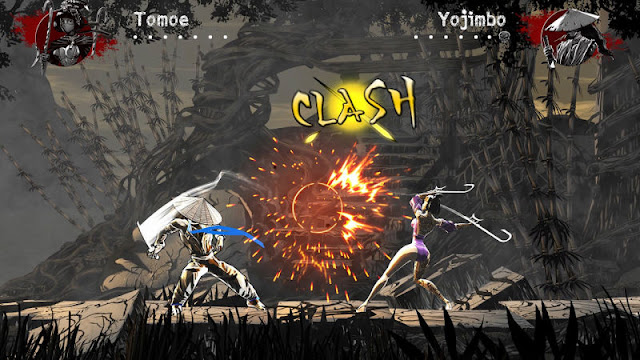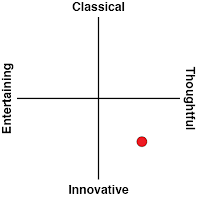Review by Matt S.
Having not played Nidhogg, and those other “one hit kill” fighting games, Slice, Dice & Rice is a wholly new kind of fighting game for me. And it’s a wholly wonderful game. With no health bars, no combos, and a single solid hit enough to win a round, the game offers an elegant, slick fencing experience, and when a single mistake will result in a lost round, the intensity can be incredible.
By conventional fighting game standards, it feels limited. There’s a tiny roster of characters, a scant few environments, and it’s all in black and white (you watch, people will mistake that for an example of “bad graphics”). But of course none of that is really the point. The point of Slice, Dice & Rice is in its sheer, complete precision. The fact that it’s possible to recognise the attack that the opponent has coming in (there are only two – fast and strong), and the block and riposte with enough practice. The fact that, once two players know the basics, the game becomes a to-and-fro, as both players wait for their opponent to make a mistake. Slice, Dice & Rice distills the strategy and skill required of a good fighting game right down to its core, but has lost none of the skills that a good fighting game demands of the player.
Backing that up is an amazing soundtrack, which combines traditional Japanese music instruments with more modern rhythms. So often in fighting games the music is high octane, fast, aggressive stuff. Which, of course, does support the speed and aggression of fighting games themselves. But Slice, Dice & Rice is something very different. The more rhythmic tones of the music help to set the speed of the game itself, and it all starts to feel very dance-like. This impressed me immediately, and actually helped keep me razor focused on the small, precise moments that can mean the difference between success and failure.
And boy can this make you sweat over success and failure. While it only takes one well-placed blow to down an opponent, it’s also possible to either block and parry attacks, or work yourself into positions where a hit is only a scrape. It’ll bloody your character, but if you stay in control of things you can use that as an opportunity to deliver a killer blow in return. Your opponent will certainly be expecting a victory after landing a blow, and it’s the tiniest of subtleties that can an experienced player can learn to read.
The game’s visceral, too. That black and white background drips with a dark fantasy atmosphere, reminiscent of Mortal Kombat, only mixed with Asian aesthetics. The game has a love of blood absolutely in-line with that other franchise, too. Heads roll, crimson’s often the only colour on the screen, and the impact sound of each hit is sickeningly wet. While there might not be many characters to choose between, each has a very different look, and you can feel the difference this makes to how they move and fight. You will feel how heavy a double handed sword is. The reaper-like character genuinely feels like he’s floating – the movement is fundamentally different.
Though each character is different enough that you’ll need to take very different approaches with each character, the game is balanced so that none have an outright advantage over any of the others. Usually I can’t stand heavy, slow characters in fighting games, because it’s too easy to pound them into oblivion with an endless stream of small, light attacks, but in this game, that tiny bit of extra reach that the heavier characters have is something lighter fighters need to be terrified off this time around. It only takes one hit, remember.
Despite the dark fantasy design and atmosphere, the game has a wicked sense of humour, again, not unlike Mortal Kombat. Through the “narrative” mode, there are snippets of storytelling which are so overwrought in their writing that it’s impossible not to laugh at the false sincerity of it. Occasionally characters will throw a line or two of dialogue at one another before a bout, and they’re the (deliberately) the worst mock-serious insults you’ll ever come across. And then loading screens have quotes such as one from an “Unknown Philosopher” telling players to “git gud.” No, for all the precision and brilliance of the combat system, Slice, Dice & Rice doesn’t take itself seriously.
It’s not perfect, though. The slightest slip of lag in playing online and a bout is ruined, and while I found the netcode decent enough, I did indeed have some bouts ruined. On the other hand, the AI just isn’t up to the task. This is a game that’s chess-like in the intellectual demand that it places on a good player, and it won’t take long for the AI to become far too easy to “read”, and therefore counter. I think the issue is that it’s just to predictable. Play against a human opponent and the best strategy of all is to throw unpredictable movements in, so the experience against the AI feels flat and overly straightforward after a while.
The game’s not going to draw the attention or community of “proper” fighting games, but Slice, Dice & Rice is distinctive, intelligent, rhythmical and, more importantly, intense. That ability to lose a match from a single button press makes every single movement count, and in that way it’s the most perfect, pure fighting game that you could hope to find. Just make sure you’ve got people to play in local multiplayer with. That’s where the game’s long term value is going to be.
– Matt S.
Editor-in-Chief
Find me on Twitter: @digitallydownld
 |
| Please Support Me On Patreon!
|









